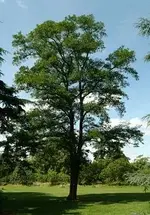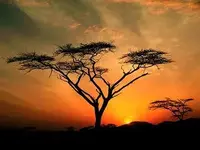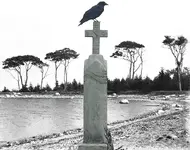Robot
Bronze Member
- #541
Thread Owner
The Sprig of Acacia

My theory “The Untold Story of the Oak Island Money Pit” claims how the Freemasons, the Original Builders of the Oak Island Treasure Depository in 1762, may have planted the many Acacia Trees located on this island.
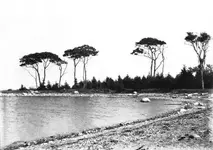
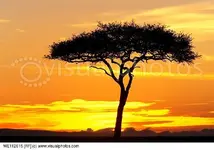
The Acacia is a revered bush and tree to the Freemasons in which they have placed many significant symbols to.
The Freemasons possibly derived these symbols from the Bible.
“The Acacia is called in the Bible, “Shittim,” which is really the plural of Shittah, which last form occurs once only in Isaiah 41: 19. It was esteemed a sacred wood among the Hebrews, and of it Moses was ordered to make the tabernacle, the Ark of the Covenant, the table for the showbread, and the rest of the sacred furniture (Exodus 25-27).”
It was thought that the “Burning Bush” Moses encountered in the wilderness was that of an Acacia Bush.
It was also believed that the Crown of Thorns placed on Jesus’s head was made from the Acacia Bush and the Cross he carried when Crucified, was made from an Acacia Tree.
God stated he would plant the Acacia Tree in the wilderness.
The Freemason’s first symbol for the Acacia is….immortality of the soul.
It has been claimed that a beam of Acacia wood, cut and placed exposed to the elements can once again sprout forth twigs.
The Freemason’s second symbol for the Acacia is… incorruptible nature of the soul.
The Acacia plant is said to be impervious to destruction from insects or animals.
The Freemason’s third symbol for the Acacia is…moral quality of innocence or purity of life.
The Freemason’s fourth symbol for the Acacia is…Initiation
“In all the ancient initiations and religious mysteries there was some plant peculiar to each, which was consecrated by its own esoteric meaning and which occupied an important position in the celebration of the rites, so that the plant, whatever it might be, from its constant and prominent use in the ceremonies of initiation, came at length to be adopted as the symbol of initiation.”
It was Strange beyond coincidence that the first settler on Oak Island, Dr Jonathan Prescott Captain of Engineers (I believe he was the original Architect and Builder of the Depository) was given Lot 8 and Lot 22.
It is Bizarre that Dr. Prescott a very wealthy businessman out of Halifax would concern himself with two small Lots located on an isolated island.
What Maybe the Truth was that Captain Prescott organized and safeguarded the island for the transitioning of their treasure over to the New World Freemasons.
It is now history, that his son Charles Ramage Prescott liked the trees planted by his father on Oak Island that he planted them around his house in the Annapolis Valley.
Today…that town is called…Acacia Grove, Nova Scotia.

My theory “The Untold Story of the Oak Island Money Pit” claims how the Freemasons, the Original Builders of the Oak Island Treasure Depository in 1762, may have planted the many Acacia Trees located on this island.


The Acacia is a revered bush and tree to the Freemasons in which they have placed many significant symbols to.
The Freemasons possibly derived these symbols from the Bible.
“The Acacia is called in the Bible, “Shittim,” which is really the plural of Shittah, which last form occurs once only in Isaiah 41: 19. It was esteemed a sacred wood among the Hebrews, and of it Moses was ordered to make the tabernacle, the Ark of the Covenant, the table for the showbread, and the rest of the sacred furniture (Exodus 25-27).”
It was thought that the “Burning Bush” Moses encountered in the wilderness was that of an Acacia Bush.
It was also believed that the Crown of Thorns placed on Jesus’s head was made from the Acacia Bush and the Cross he carried when Crucified, was made from an Acacia Tree.
God stated he would plant the Acacia Tree in the wilderness.
The Freemason’s first symbol for the Acacia is….immortality of the soul.
It has been claimed that a beam of Acacia wood, cut and placed exposed to the elements can once again sprout forth twigs.
The Freemason’s second symbol for the Acacia is… incorruptible nature of the soul.
The Acacia plant is said to be impervious to destruction from insects or animals.
The Freemason’s third symbol for the Acacia is…moral quality of innocence or purity of life.
The Freemason’s fourth symbol for the Acacia is…Initiation
“In all the ancient initiations and religious mysteries there was some plant peculiar to each, which was consecrated by its own esoteric meaning and which occupied an important position in the celebration of the rites, so that the plant, whatever it might be, from its constant and prominent use in the ceremonies of initiation, came at length to be adopted as the symbol of initiation.”
It was Strange beyond coincidence that the first settler on Oak Island, Dr Jonathan Prescott Captain of Engineers (I believe he was the original Architect and Builder of the Depository) was given Lot 8 and Lot 22.
It is Bizarre that Dr. Prescott a very wealthy businessman out of Halifax would concern himself with two small Lots located on an isolated island.
What Maybe the Truth was that Captain Prescott organized and safeguarded the island for the transitioning of their treasure over to the New World Freemasons.
It is now history, that his son Charles Ramage Prescott liked the trees planted by his father on Oak Island that he planted them around his house in the Annapolis Valley.
Today…that town is called…Acacia Grove, Nova Scotia.
Amazon Forum Fav 👍
Last edited:






